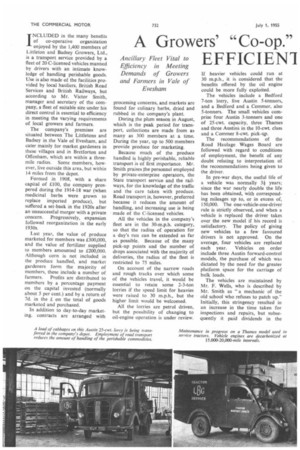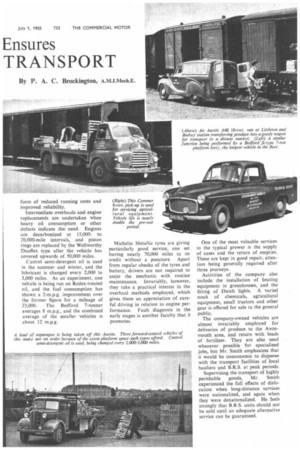A Growers' "Co-op." Ensures EFFICIEN1 TRANSPORT
Page 68

Page 69

If you've noticed an error in this article please click here to report it so we can fix it.
By P. A. C. Brockington,
INCLUDED in the many benefits of co-operative organization enjoyed by the 1,400 members of Littleton and Badsey Growers, Ltd., is a transport service provided by a fleet of 20 C-licensed vehicles manned by drivers with an intimate knowledge of handling perishable goods. Use is also made of the facilities provided by local hauliers, British Road Services and British Railways, but according to Mr. Victor Smith, manager and secretary of the company, a fleet of suitable size under his direct control is essential to efficiency in meeting the varying requirements of local growers and farmers.
The company's premises are situated between The Littletons and Badsey in the Vale of Evesham, and cater mainly for market gardeners in these villages and in Bretforton and Offenham, which are within a threemile radius. Some members, however, live outside this area, but within 14 miles from the depot.
Formed in 1908, with a share capital of £100, the company prospered during the 1914-18 war (when medicinal herbs were grown to replace imported produce), but suffered a set-back in the 1920s after an unsuccessful merger with a private concern. Progressively, expansion followed reorganization in the early 1930s.
Last year, the value of produce marketed for members was £300,000, and the value of fertilizer supplied to members amounted to £200,000. Although corn is not included in the produce handled, and market gardeners form the majority of members, these include a number of farmers. Profits are distributed to members by a percentage payment on the capital invested (normally about 5 per cent.) and by a return of 7d. in the £ on the total of goods marketed and purchased.
In addition to day-to-day marketing, contracts are arranged with processing concerns, and markets are found for culinary herbs, dried and rubbed in the company's plant.
During the plum season in August, which is the peak period for transport, collections are made from as many as 300 members at a time. During the year, up to 500 members provide produce for marketing.
Because much of the produce handled is highly perishable, reliable transport is of first importance. Mr. Smith praises the personnel employed by private-enterprise operators, the State transport service and the railways, for the knowledge of the traffic and the care taken with produce. Road transport is, however, preferred because it reduces the amount of handling, and increasing use is being made of the C-licensed vehicles.
All the vehicles in the company's fleet are in the 30-m.p.h. category, so that the radius of operation for a day's run can be extended as far as possible. Because of the many pick-up points and the number of drops associated with the majority of deliveries, the radius of the fleet is restricted to 75 miles.
On account of the narrow roads and rough tracks over which some of the vehicles travel, it would be essential to retain some 2-3-ton lorries if the speed limit for heavies were raised to 30 m.p.h., but the higher limit would be welcomed.
All the lorries are petrol driven, but the possibility of changing to oil-engine operation is under review. If heavier vehicles could run at 30 m.p.h., it is considered that the benefits offered by the oil engine could be more fully exploited.
The vehicles include a Bedford 7-ton lorry, five Austin 5-tonners, and a Bedford and a Commer, also 5-tonners. The small vehicles comprise four Austin 3-tonners and one of 25-cwt. capacity, three Thames and three AustinS in the 10-cwt. class and a Commer 8-cwt. pick-n,p.
The recommendations of the Road Haulage Wages Board are followed with regard to conditions of employment, the benefit of any doubt relating to interpretation of the recommendations being given to the driver.
In pre-war days, the useful life of a vehicle was normally a years; since the war nearly double the life has been obtained, with corresponding mileages up to, or in excess of, 150,000. The one-vehicle-one-driver rule is strictly observed, and when a vehicle is replaced the driver takes over the new model if his record is satisfactory. The policy of giving new vehicles to a few favoured drivers is not approved. On the average, four vehicles are replaced each year. Vehicles on order include three Austin forward-control models, the purchase of which was dictated by the need for the greater platform space for the carriage of bulk loads.
The vehicles are maintained by Mr. F. Wells, who is described by Mr. Smith as "a mechanic of the old school who refuses to patch up." Initially, this stringency resulted in an increase in the time taken for inspections and repairs, but subsequently it paid dividends in the form of reduced running costs and improved reliability.
Intermediate overhauls and engine replacements are undertaken when heavy oil consumption or other defects indicate the need. Engines are decarbonized at 15,000to 20,000-mile intervals, and piston rings are replaced by the Wellworthy Duaflex type after the vehicle has covered upwards of 50,000 miles.
Castrol semi-detergent oil is used in the summer and winter, and the lubricant is changed every 2,000 to 3,000 miles. As an experiment, one vehicle is being run on Redex-treated oil, and the fuel consumption has shown a 2-m.p.g. improvement over the former figure for a mileage of 23,000. The Bedford 7-tonner averages 8 m.p.g., and the combined average of the smaller vehicles is about 12 m.p.g. Michelin Metallic tyres are giving particularly good service, one set having nearly 70,000 miles to its credit without a puncture. Apart from regular checks of the tyres and battery, drivers are not required to assist the mechanic with routine maintenance. Invariably, however, they take a practical interest in the overhaul methods employed, which gives them an appreciation of careful driving in relation to engine performance. Fault diagnosis in the early stages is another faculty that it promotes. One of the most valuable services to the typical grower is the supply of cases and the return of empties. These are kept in good repair, attention being generally required after three journeys.
Activities of the company also include the installation of heating equipment in greenhouses, and the fitting of Dutch lights. A varied stock of chemicals, agricultural equipment, small tractors and other gear is offered for sale to the general public.
The company-owned vehicles are almost invariably employed for deliveries of produce to the Avonmouth area, and return with loads of fertilizer. They are also used whenever possible for specialized jobs, but Mr. Smith emphasizes that it would be uneconomic to dispense with the transport facilities of local hauliers and B.R.S. at peak periods.
Supervising the transport of highly perishable goods, Mr. Smith experienced the full effects of dislocation when long-distance services were nationalized, and again when they were denationalized. He feels strongly that I3.R.S. units should not be sold until an adequate alternative service can be guaranteed.












































































































































